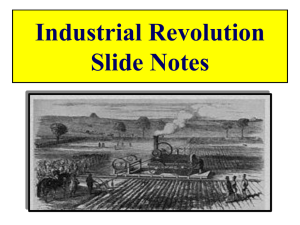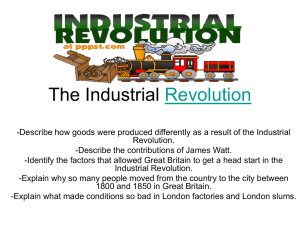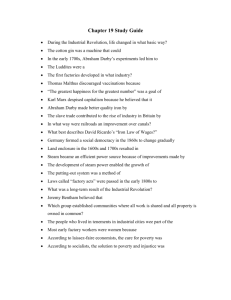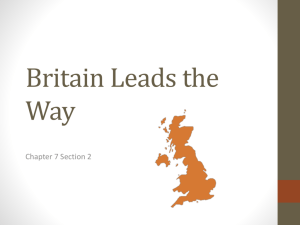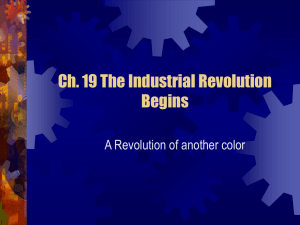AGE OF INDUSTRY CH. 12 AND 13.1 PAGES 374-401
advertisement
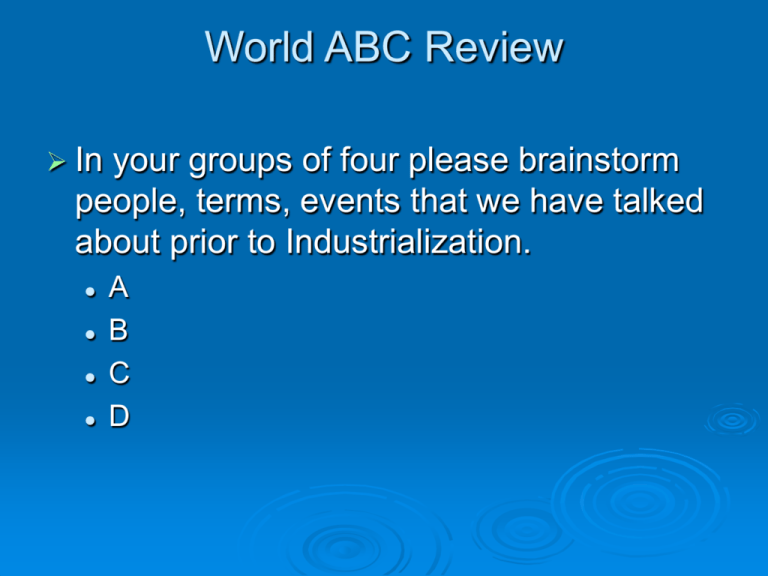
World ABC Review In your groups of four please brainstorm people, terms, events that we have talked about prior to Industrialization. A B C D AGE OF INDUSTRY CH. 12 AND 13.1 PAGES 374-401 Standard: Strand 2: World History; Concept 6: Age of Revolution; PO 6: Analyze the social, political, and economic development and impact of the Industrial Revolution: a. origins in England’s textile and mining industries. b. urban growth and the social impact of industrialization c. unequal spread of industrialization to other countries d. political and economic theories (nationalism, anarchism, capitalism, socialism) Please open your textbook to page 374 As a class we will read the Storyteller… We will brainstorm the historical significance questions. Terms, people, and events to know for Industrial Revolution: Ch. 12 Illustrated Vocabulary: 1. Domestic system 2. Enclosure movement 3. Capital 4. Entrepreneur 5. Factory system 6. Industrial capitalism 7. Interchangeable parts 8. Division of labor 9. Partnership 10. Corporation 11. Depression 12. Labor union-tactics 13. Collective bargaining 1. 2. 3. 4. 5. 6. 7. 8. 9. 10. Eli Whitney James Watt Robert Fulton Frederick Taylor Henry Ford Samuel Morse Alexander Graham Bell Thomas Edison Rudolf Diesel Wilbur and Orville Wright Industrial Revolution The Industrial Revolution occurred in several stages, each of which was dependent upon the previous stage. Agricultural Revolution Cottage Industry Factory System Steam Engine Traditional or Pre-Industrial Society Farming in the Middle Ages Disadvantages Villages feed themselves One of three fields left fallow (empty) to regain fertility Animals grazed in common pastures. Farmers did not experiment with new farming methods. Land use was inefficient Farmers didn’t experiment with new farming methods. Forces for Change Population growing – more food needed. French blockade –no corn– more food needed. The Agricultural Revolution Enclosure Movement -pg. 379 Crop Rotation -pg. 379 Fields depleted of nutrients by one crop, replenished by planting different crops Fields not left fallow Other Discoveries Wealthy landlords fenced in common pastures and experimented with new farming technology. Villages lost common lands and political power, peasants became poorer. Seed drill -Planted seeds more efficiently New crops —corn and potatoes Results of Agricultural Revolution More food Population increased Create a visual of the previous notes agricultural revolution Cottage Industry = Early Capitalism Mercantilism-- Cottage Industry An economic system based on private ownership, free competition, and profit Cottage industry is an example of early capitalism Effects of Cottage Industry Merchants supplied materials—wool and cotton to cottages to be carded and spun. Multiple cottages provided services to produce cloth; supplies went from spinning cottage to weaving cottage to dying cottage to sell finished cloth. Merchants sell product for more than material and labor costs= profit + larger investment = higher profit Capitalism-money to invest in labor, machines, and raw materials Economic theory of the 1600s Stated a nation should maintain and increase its wealth by exporting more goods than it was importing Placed limits of purchasing goods Big profits for new class of merchants Alternative source of income for peasants YouTube - Conan O'Brien, American Express - "Curtain“ Cottage Industry Create a visual of the previous notes Cottage Industry TEXTILE INDUSTRY AND FACTORY SYSTEM Textile Industry invented Cottage industry could not keep up with new demand Spinning jenny, water frame, spinning mule—all improved spinning Power loom sped up weaving Cotton gin separated seeds from cotton—Eli Whitney Rise of the Factory System Brought workers and machines together under the control of managers. Factories located near power source: coal, iron, water….. • Waterways powered the machines and transported items. Industrial developments Led to the invention of the more efficient steam engine —help set industrial revolution into full motion. Factory machinery increased demand for iron and steel. Private companies began building and paving roads; led to drainage systems. First modern canal built in 1761. First practical Steam boat invented in 1807 Effects of Textile Factories in Britain Prices of mass-produced textiles were much lower than hand- produced items Britain’s textile industry increased enormously Majority of villagers forced to leave to find work in urban factories. Textile and Factory Create a visual of the previous notes Textile industry Factory system Steam Engine: Energy for the Industrial Revolution The need for Energy How the Steam Engine Works Early factories relied on horses, oxen, and water mills Steam engine evolved in response to the increasing need for power Steam forced from high to low pressure produces power. Effect of Steam Engine Steam power, used where ever coal existed, increased textile production Improved mining which increased metals which in turn fueled other industries. Steam Engine Invented by James Watt in the 1760s Create a visual of the previous notes Energy for the Industrial Revolution Iron and Coal: Energy for the IR The need for Iron The need for coal Farming tools, new factory machinery, railways Smelting makes iron more pure, but requires carbon Carbon necessary for smelting iron Steam engines powered by coal Effect of Iron and Coal Britain produced more iron than all other countries of the world combined Coal powered Britain’s enormous navy. Transportation The need for better Transportation Inventions Increased production increased need to transport goods quickly and cheaply Pre-industrial society used horses, mules, and dirt roads Stone and eventually asphalt roads Canals Railroad era ushered in with the Rocket in 1829 Effects of RR Expanded rapidly throughout Britain Cheaper transportation increased production and profits Railways fueled other industries: coal, steam engines, iron, steel, and many manufactured products. Steam Engine Please open your book to page 395 and look at the map showing the Industrial Revolution: England 1850-1870 Create a visual of the previous notes Why Britain led the Industrial Revolution Geography Government British society less rigid than other European countries Colonial Empire internal trade encouraged Population allowed to relocate Helped build canals and road Social Factors Climate good for textile production. Plenty of natural resources such as iron and coal. Separation from the European continent kept them out of wars. Supplied raw material for manufactured goods Provided market for goods Advantages of Industrializing First No other countries competing for manufactured goods Monopoly on technology Closure: Think about writing an editorial on why the Industrial Revolution was able to start in Great Britain…..another day. People of IR Eli Whitney James Watt Robert Fulton Frederick Taylor Henry Ford Samuel Morse Alexander Graham Bell Thomas Edison Rudolf Diesel Wilbur and Orville Wright

